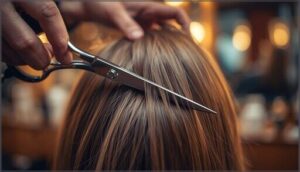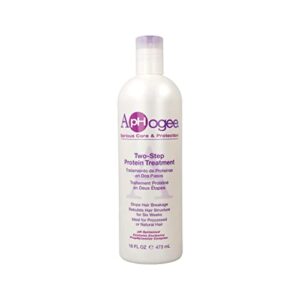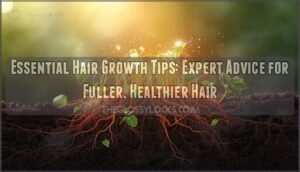This site is supported by our readers. We may earn a commission, at no cost to you, if you purchase through links.
You run your fingers through wet hair after a shower, expecting smooth strands—but instead, they feel sticky, stretchy, and weirdly elastic. That strange, mushy texture is gummy hair, and it’s your hair screaming that something’s gone seriously wrong.
Usually, it’s the result of chemical overload from bleaching, chronic heat damage, or a severe protein-moisture imbalance that’s left your strands structurally compromised.
The good news? Gummy hair isn’t a permanent sentence. With the right combination of protein treatments, deep conditioning, and strategic damage control, you can rebuild what’s been broken down and get your hair back to a healthy state—but you’ll need to act fast before the damage becomes irreversible.
Table Of Contents
Key Takeaways
- Gummy hair happens when chemical overload (especially bleaching), heat damage, or protein-moisture imbalance destroys your hair’s internal structure, making strands stretchy, sticky, and rubbery when wet—but it’s fixable with fast action before damage becomes permanent.
- The repair strategy requires alternating protein treatments (like Aphogee) to rebuild broken bonds with deep conditioning to restore moisture balance, since protein alone makes hair stiff while moisture alone won’t fix structural damage.
- Prevention beats cure: washing less than three times weekly cuts protein loss by 72%, while protective styling reduces breakage by 70%—but you need to ditch heat above 140°C and space out chemical treatments to stop the damage cycle.
- If your hair keeps breaking despite home treatments, or you’re seeing scalp inflammation and patchy hair loss, it’s time to see a dermatologist or trichologist because some underlying issues can’t be fixed with products alone.
Why Hair Becomes Gummy
If your hair feels sticky, stretchy, or rubbery when wet, you’re dealing with what stylists call gummy hair—and trust me, it’s more common than you think. This condition happens when your hair’s internal structure gets compromised, usually from bleach, chemical treatments, or a buildup of products and moisture.
Let’s break down exactly what causes this texture nightmare, how to spot the warning signs, and what’s actually happening inside each damaged strand.
Causes of Gummy Hair (Chemical Damage, Overprocessing, Product Buildup)
Your hair turns gummy when chemical processing, overprocessing, or product buildup pushes it past its breaking point. Here’s what’s really going on:
- Chemical overload from bleaching and hair damage strips away proteins, making strands stretchy and weak
- Overprocessed hair loses its natural structure after repeated treatments
- Product residue clogs follicles, causing scalp irritation
- Hair fiber damage from heat and chemicals creates that sticky, rubbery texture
Prevention starts with understanding these triggers. Regular hair care routines should avoid hair product buildup to maintain healthy hair.
Common Symptoms of Gummy Hair
Once you spot the signs, you can take action. Gummy texture shows up as sticky, mushy strands when wet—your hair elasticity is shot.
You’ll notice increased hair breakage, tangling issues that make brushing a nightmare, and a dull appearance that screams hair damage. The moisture imbalance leaves your hair stretchy but weak, with zero hair strength or bounce.
Understanding hair damage causes is key to addressing these issues.
How Hair Structure Changes When Damaged
When those symptoms show up, structural alterations are already happening inside each strand. Chemical treatments crack open your hair cuticle, exposing the inner cortex to protein depletion and fiber weakening.
The result? Your hair can stretch 30% to 70% beyond normal—that’s why it feels gummy. This moisture imbalance destroys your hair structure from the inside out, making hair breakage inevitable without protein treatments.
Damaged hair stretches up to 70% beyond normal, creating that gummy texture and inevitable breakage without protein intervention
Effective Ways to Fix Gummy Hair
If your hair feels sticky, stretchy, or just plain weird, you’re not stuck with it forever. The good news is that gummy hair can be fixed with the right approach, even if it takes some patience.
Let’s walk through the most effective methods to get your hair back to feeling strong, healthy, and normal again.
Protein Treatments and How They Work
Think of protein treatments as your hair’s emergency rescue squad—they swoop in with amino acids and keratin to patch up damage from the inside out.
Products like Aphogee work by filling microscopic gaps in your hair shaft, rebuilding strength where bleach or heat styling has stripped it away.
These treatments literally reconstruct what’s been lost, turning rubbery strands back into resilient, manageable hair.
Deep Conditioning and Moisturizing Methods
Balance is everything when you’re fighting gummy texture—after protein repair, your hair craves moisture to stay flexible and strong.
Weekly deep conditioning restores that equilibrium, with hydrating treatments left on for 20–30 minutes showing a 40% improvement in softness.
- Apply moisturizing hair masks with avocado or coconut oil for enhanced elasticity
- Use a heat cap during deep conditioners to boost absorption by 15%
- Rinse with cool water to seal cuticles and lock in moisture
Cutting and Trimming Severely Damaged Hair
Sometimes your best move is a pair of sharp scissors—when repair treatments can’t restore integrity, cutting severely damaged hair stops breakage in its tracks. Experts recommend trimming every 6–8 weeks for gummy hair damage, removing split ends before they climb upward.
If you’re dealing with extreme brittleness, a professional “big chop” eliminates structural weaknesses completely, letting healthier strands flourish with proper post-cut care and gentler styling habits moving forward.
Reducing Heat and Chemical Exposure
You can’t undo gummy hair while constantly hammering it with heat and chemicals—temperatures above 140°C permanently wreck keratin fibers, and chemical treatments shred disulfide bonds.
Switch to air-drying or low-heat settings with Heat Protection Methods, embrace Chemical Free Alternatives, and adopt Safe Styling Practices.
This shift toward Gentle Hair Care and Damage Prevention Tips halts further Bleaching and Hair Damage while supporting lasting Hair Damage Repair.
Gentle Styling and Hair Care Techniques
Treat your hair like delicate silk—swap your regular brush for a wide-tooth comb for Gentle Detangling, choose Soft Hair Tools like boar bristle brushes, and embrace Minimal Styling to prevent further Gummy Hair damage.
Lock in Moisturizing Treatments with a silk pillowcase Nighttime Routine, add Hair Oil Benefits through lightweight serums, and watch your Hair Health transform through consistent, gentle Hair Care and Hair Damage Repair.
Top 5 Products to Repair Gummy Hair
You’ve learned what causes gummy hair and how to treat it—now let’s talk about the products that actually work.
The right combination of protein, moisture, and gentle cleansing can make a real difference in bringing your hair back to life.
Here are five targeted products that address the core issues behind gummy, overprocessed hair.
1. Protein Treatment For Damaged Hair
When your hair snaps like a rubber band, protein treatments become your strongest ally. Aphogee 2-Step stands out as a powerhouse for damage restoration—it literally rebuilds your hair’s structure within six weeks by reconnecting broken bonds. This protein treatment works by coating each strand with hydrolyzed proteins, filling gaps and restoring strength. You’ll notice reduced breakage and improved elasticity after consistent use.
For a DIY approach, egg white protein treatments offer gentle hair strengthening between professional applications, giving you control over your hair rebuilding journey.
Best For: People with severely damaged, overprocessed, or chemically treated hair who need intensive structural repair and are willing to follow a specific application process.
- Rebuilds hair structure from the inside out within six weeks by reconnecting broken protein bonds and filling gaps in damaged strands.
- Significantly reduces breakage and can increase hair strength by nearly double, making it particularly effective for bleached, permed, or heat-damaged hair.
- Cruelty-free formula that improves elasticity and manageability, leading to smoother, shinier hair with fewer split ends.
- Application can be messy and sticky, requiring careful timing and a specific process that some users find inconvenient.
- Can cause dryness or stiffness if not balanced with moisturizing treatments, making follow-up conditioning essential.
- Not suitable for healthy or mildly damaged hair—it’s designed only for severely compromised strands and can cause brittleness if overused.
2. Damaged Hair Repair Shampoo Treatment
Your wash routine can either rescue or ruin gummy hair—that’s why choosing the right shampoo ingredients matters immensely. Look for sulfate-free formulas with bond-building technology that penetrate deep into your hair’s cortex for genuine hair repair. These shampoos reduce breakage by up to 99% when used consistently, supporting both gentle cleansing and damage prevention.
Pair your repair shampoo with protein treatments for maximum hair restoration—together they create a powerful defense against further deterioration while rebuilding what chemical damage destroyed.
Best For: Anyone with permed, color-treated, or chemically damaged hair who needs to rebuild strength and restore shine without stripping natural oils.
- Clinically proven to reduce breakage by up to 99% when used with complementary treatments, making it highly effective for damaged strands.
- Sulfate-free formula with bond-building technology penetrates deep into the hair cortex to repair from within while normalizing pH levels.
- Works well on multiple hair types including curly, frizzy, and relaxed hair, restoring natural beauty and improving overall hair resilience.
- Can dry out hair if overused, so it’s recommended only once or twice a month rather than for daily washing.
- Requires pairing with deep conditioning treatments between uses to maintain moisture balance and prevent further dryness.
- Some users report an unpleasant smell that may be off-putting during application.
3. Aphogee Hair Moisturizing Balance Cream
After your protein treatment comes the key ingredient: Aphogee Hair Moisturizing Balance Cream locks in that protein infusion while flooding your strands with essential hydration. This cream’s Pro-Phytamine complex—packed with collagen amino acids and vitamin E—prevents your hair from feeling stiff or brittle post-treatment.
Users report their straw-like gummy hair transforms into softer, manageable strands when they massage this formula into damp hair for just two minutes. The secret? It maintains your hair’s natural pH between 4.0-5.5, keeping moisture and strength perfectly balanced for genuine hair repair.
Best For: Anyone with chemically treated, heat-damaged, or protein-treated hair who needs to restore moisture balance without sacrificing strength.
- Works fast—just two minutes to transform straw-like hair into soft, manageable strands with the Pro-Phytamine complex of collagen amino acids and vitamin E.
- Maintains your hair’s natural pH (4.0-5.5) so you get the moisture-protein balance right, preventing that stiff, brittle feeling after treatments.
- Versatile enough to use as a post-treatment essential or daily moisturizing conditioner, making it easy to keep hair soft between protein sessions.
- The scent isn’t everyone’s favorite, which might be a dealbreaker if you’re sensitive to product fragrances.
- Extremely dry hair might need an extra moisturizing boost beyond what this cream provides on its own.
- No clear sulfate-free or paraben-free labeling, and ingredient details are limited if you’re particular about what goes on your hair.
4. Mielle Organics Babassu Mint Conditioner
Your damaged strands need more than just protein—they’re craving that moisture-protein sweet spot. Mielle Organics Babassu Mint Conditioner delivers exactly that with its lightweight formula that won’t weigh down your recovering hair.
The babassu oil from Amazonian palms plus hydrated wheat protein work together to rebuild elasticity while keeping your strands soft and detangled. That cooling mint sensation? It’s actually stimulating your scalp and signaling real nourishment is happening.
Users with high porosity and chemically treated gummy hair report improved manageability after just one deep conditioning session.
Best For: People with high porosity, chemically treated, or damaged hair who need to restore moisture-protein balance without weighing down their strands.
- Lightweight protein treatment that rebuilds elasticity and strength while keeping hair soft and detangled, not stiff or crunchy
- Works across all curl types (3A-4C) and is safe for color-treated hair with sulfate-free, paraben-free, cruelty-free ingredients
- Cooling mint and babassu oil formula provides immediate scalp stimulation and noticeable results after just one deep conditioning session
- Small container size makes it expensive for the amount of product you actually get
- Strong menthol scent might be overwhelming if you’re sensitive to mint or prefer fragrance-free products
- Some users report packaging issues like loose seals or leaking containers upon delivery
5. Deep Cleansing Color Safe Shampoo
Before reaching for another deep conditioner, you need to address what’s trapping all that gunk in your strands. A clarifying shampoo designed for color protection strips away mineral deposits and product buildup without fading your color—critical when you’re layering protein treatments and deep moisturizing masks.
Look for sulfate-free formulas with gentle cleansing agents. Use it once weekly between your protein treatment sessions to reset your hair’s baseline. Clean hair absorbs conditioning treatments more effectively, making your entire gummy hair repair routine actually work.
Best For: Anyone dealing with gummy, weighed-down hair from product buildup or hard water—especially if you have color-treated hair and need a deep reset without stripping your dye.
- Removes mineral deposits and product residue that block conditioning treatments from working, so your hair can actually absorb the moisture and protein it needs.
- Color-safe formulas let you clarify weekly without fading highlights, balayage, or permanent color—perfect for maintaining vibrant hair while fixing texture issues.
- Sulfate-free options clean deeply without over-drying, making them gentle enough to use regularly between protein treatments.
- Overuse can dry out your hair if you’re not following up with a good moisturizing conditioner or mask.
- Some formulas still contain harsh sulfates that might strip semi-permanent or vivid colors faster than you’d like.
- Not meant for daily washing—you’ll need to stick to a once-weekly or bi-weekly schedule, which requires a bit more planning than regular shampoo.
Preventing Gummy Hair in The Future
Once you’ve repaired your gummy hair, the real work begins—keeping it healthy so you never end up here again. Prevention isn’t about flawlessness; it’s about building smarter habits that protect your hair from future damage.
Let’s walk through the essential routines and styling strategies. We’ll also cover the signs that tell you when it’s time to call in a professional.
Best Hair Care Routine for Damaged Hair
Your hair needs a solid routine to bounce back from damage and keep gummy hair at bay. Start by cutting wash days to under three times weekly—this alone slashes protein loss by up to 72%. Think of it as giving your strands breathing room to rebuild.
- Deep condition weekly with protein treatments or hair masks to restore strength and moisture balance
- Use hair oils like coconut oil before washing to smooth the surface and protect against further hair damage
- Practice gentle combing with wide-tooth tools and prioritize scalp care to support healthy regrowth
Consistency beats everything when you’re repairing damaged hair.
Protective Styling and Maintenance Tips
Shielding your strands in braids or twists cuts breakage by up to 70% when you rotate styles and keep tension light. Gentle installation matters—tight styles tug at follicles and thin your hairline over time.
| Maintenance Move | Benefit |
|---|---|
| Cleanse scalp every two weeks | Prevents buildup, keeps scalp healthy |
| Apply lightweight oils | Locks in Moisture Retention |
| Limit style duration to 6–8 weeks | Reduces matting and breakage |
| Deep condition before installing | Boosts moisture by 60% |
| Take one-week breaks between styles | Lowers traction damage by 40% |
These habits protect your hair nourishment efforts while promoting steady growth.
When to Seek Professional Help
Persistent breakage despite treatment signals it’s time for Professional Guidance. Dermatologists can spot underlying issues that home remedies can’t fix.
If you’re losing patches, seeing scalp inflammation, or watching strands snap after multiple protein treatments, book a Trichology Consultation or Dermatologist Referral.
Emergency Hair Care through salon services or Hair Loss Therapy can halt damage before it becomes permanent, giving your Hair Restoration a fighting chance.
Frequently Asked Questions (FAQs)
Can gummy hair be reversed completely?
Unfortunately, complete reversal isn’t realistic—chemically damaged hair can’t fully bounce back to its pre-damage state.
However, protein treatments and deep conditioning dramatically improve texture, strength, and manageability with consistent hair restoration efforts.
How long does gummy hair recovery take?
Recovery timeline depends on damage assessment—mild cases improve within 4-6 weeks with protein treatment, while severe gummy hair requires 6-12 months.
Hair regrowth and consistent treatment frequency determine your recovery outcomes and overall hair restoration and repair success.
Does diet affect gummy hair condition?
Your diet absolutely impacts gummy hair—nutrient deficiencies in protein intake, biotin, and zinc weaken your hair’s structure.
Hair supplements and dietary changes supporting hair growth can restore strength and prevent hair damage over time.
Is gummy hair more common in certain hair types?
Nearly half of individuals with curly or kinky hair report damage symptoms, making gummy hair texture far more common in these fragile, high-porosity curl patterns.
Fine hair also faces increased vulnerability to product buildup and structural weakening.
Can supplements help repair gummy hair faster?
Supplements like biotin, collagen, and vitamin therapy can support hair repair by addressing nutrient deficiencies, but they work best alongside protein treatments and proper hair care—they’re boosters, not standalone fixes for gummy hair damage.
Conclusion
Here’s the truth: up to 95% of chronic hair damage stems from repeated chemical processing and heat styling—but your hair can heal if you’re willing to commit.
Learning how to fix gummy hair means rebuilding structure with protein, restoring moisture balance, and protecting what’s left while new growth comes in.
Start now, stay consistent with treatments, and you’ll reclaim the healthy, resilient hair you thought was gone for good.
- https://thicktails.com/blogs/stimulate-hair-growth/natural-remedies-for-gummy-and-rubbery-hair
- https://www.nexxus.com/us/en/haircare-101/how-to-repair-bleached-hair.html
- https://limmerhtc.com/what-are-hair-gummies-and-do-they-work/
- https://www.reddit.com/r/HairDye/comments/16ew2fy/how_do_i_save_my_hair_gummy_breakage_dull_tangled/
- https://wimpoleclinic.com/blog/do-hair-gummies-work-for-hair-growth/












